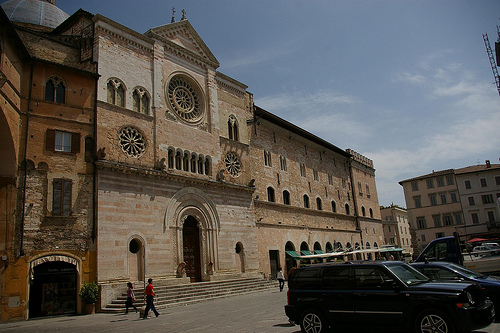Foligno, located in the heart of the Umbrian plain and surrounded by beautiful mountains, is a city of Umbrian origin. In the Roman period it was first a municipality, then the seat of a prefecture, and finally, together with the destroyed city of “Foro Flaminio”, “Statio Principalis” of imperial traffic on the proconsular Via Flaminia. The problem linked to the origin of the name is much debated, because it is very uncertain. Various writers of the Latin era, including Cicero, Caesar, Pliny, although never naming the city, referred to its inhabitants by calling them “Fulginates”, a word that may derive from Fulginium, Fulgincum, or Fulginca. Some historians have then put forward the hypothesis according to which the etymology of this word can be traced back to the Latin “Fulgeo” or “Fulgeos”. It is more likely, however, that the name derives from the ancient divinity, which the Umbrians called “i Fuigura” and which the Romans changed to “Fulginea”, a divinity highly venerated in the area. The most reliable document that seems to support these hypotheses better than others is that of Monsignor Francesco Patrizi, governor of Foligno who, writing to his brother Agostino on 10/27/1461 a few months after his festive entry into the city, communicated between the other, to have seen a temple a mile from Foligno, largely destroyed, in which there was an inscription which stated that Foligno took its name from the goddess Fuìgínea to whom the temple was dedicated. Unfortunately this inscription has never been found again. It can therefore be thought that, while the ancient form “Fulginea” was preserved among notaries and people with a certain culture, in common oral usage it is possible that the city was already called “Fulginium” around the 19th century, as still another part, today in popular lips.
If the origin of the name Foligno is uncertain, the place where the original nucleus which later gave birth to our city was built in ancient times is no longer certain.
Fulginia, or whatever it was called, certainly arose a few centuries before the Christian era by a population that arrived around the century. XI BC from the north of the Balkan peninsula and speaking a language similar to Greek. However, the traces of the original location are so faint that scholars have always been uncertain about identifying the exact point where the ancient settlement was built. Despite its vagueness, the most precise indication is provided by Silvio Italico who incidentally recalls Fulginia without walls in a vast and fertile region. The “ITINERARIUM ANTONIUM”, the most complete of the four itineraries that have come down to us, recalls Mevaniae, Nuceriae and not Fulginiac. The “ITINERARIUM HIEROSOLYMITANUM” indicates the “Civitas Fulgini” a few miles from the “Civitas Trevis” but does not mention the “Forum Flamini”. Other ancient documents refer to Spello and Bevagna, to “Foro-Flamini”, to Nocera, but not to Fulginea. This therefore results in a situation of extreme uncertainty. In fact, the most important scholars of the ancient things of Foligno, Dominici and Faloci, present different theses: the first sees ancient Foligno on the current site, admitting the existence of some villas in the hilly area. the second sees a Fulginia located on the hill of Santa Maria in Campis and the Cimitero. Dominici justifies his assumption by referring to the poet Silvio Italico, who speaks of a Fulginia in the fields and without walls, and at the same time to the existence of four bridges along the course of the Topino in the space of a single kilometer (this could not be justified if the ancient nucleus was not had been an active and populated city along the Topino). Faloci instead supports his statements with the fact that, in the area of the current Cemetery, important archaeological finds and evidence of ancient buildings have emerged and still appear today.

